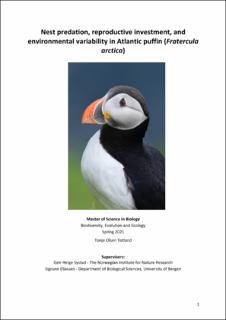Nest predation, reproductive investment, and environmental variability in Atlantic puffin (Fratercula arctica)
Master thesis
Permanent lenke
https://hdl.handle.net/11250/2773595Utgivelsesdato
2021-06-30Metadata
Vis full innførselSamlinger
- Master theses [263]
Sammendrag
For many species of birds, nest predation is one of the leading causes of reproductive failure. This has been especially apparent in island nesting seabirds, which have experienced rapid declines due to the introduction of mammalian predators. This study examines how nest predation varies between years in the Atlantic puffin (Fratercula arctica) colony at Hjelmsøya in Northern Norway. Further, we assess whether this variation can be linked to female condition and if this is affected by environmental fluctuations. To determine female condition, egg size was used as a proxy in this study. I found that predation rates were higher in years with lower egg volume. This indicates that: 1) Female condition is poor during seasons with low food availability, and they have less energy to invest in eggs. 2) If the perception of predation is high in the local area, females invest less in eggs because survival prospects and the reproductive value of offspring are low. The variation in egg size could best be explained by the indirect effects of climatic variables through the abundance of important prey. This study provides new insights into the connection between environmental conditions, parental investment, and predation in a puffin population. Therefore, this study may be a valuable asset for future conservation initiatives for this vulnerable species.
